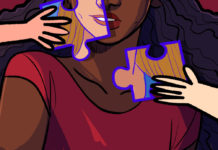Salma Baheyeldin, a 2A global business and digital arts (GBDA) student, begins our conversation by telling me about an old childhood dilemma she had. “I’ve always been interested in art in general as a child, but I was never one who enjoyed drawing in general or sketching. I really disliked physical drawing.”
For most kids, that would have meant they wouldn’t be asking their parents for a paint set for their birthday. But Baheyeldin found herself at a crossroads — how could she hone her artistic skill sets without adhering to the constraints of traditional pen-and-paper?
She resolved this conundrum with graphic design.
Baheyeldin began expressing herself through digital means by creating her own wallpapers and experimenting with platforms like ProCreate to create fanart. “Digital drawings are like a cheat sheet,” she explains, and graphic design allows her “to showcase my design abilities on a larger scale.”
I immediately understand what she means by this larger scale the second she pulls out her iPad to show me some of her work. Her digital art gallery holds everything from a piece of animated Harry Potter fan art (I can’t help but rave about the foam on the miniature Butterbeer) to a satirical comic strip on performative activism (which she insists I don’t publish since she feels it’s not “reflective enough” of her style). In between scrolling through home screens, I also glimpse a cartoonish Cheshire Cat and a naturalistic sketch of an octopus. Across each piece, her style shifts with fluidity, alternating between thin, pencil-like strokes to more hazy brushstrokes with the click of a button.
“I’m always thinking with an artist’s mind,” Baheyeldin tells me. “I always have to be prepared to whip out my iPad and start drawing or designing or creating.”
Her “artist’s mind” or extreme attention to detail in day-to-day life is one that I’ve witnessed firsthand. She’s quick to notice a nearby poster while strolling on campus or a new hairstyle no matter how subtle. Even her clothes, which consist of green and silver accents that match her jewellery, signal a person who cares about particulars. While she does not take herself super seriously (she’s quick to make a self-deprecating quip about how screwed she is for exams), she still comes across as someone prepared and put-together.
When I ask why she chose Waterloo’s GBDA program, she concisely explains that it offered a “realistic way to pursue art” as it combines both design and business. The technical skills she’s learning focus on creating user-friendly designs, equipping her for a career in marketing and product design. Baheyeldin says she can totally see herself “making some cute packaging.”
As sure as she seems, there is still the occasional moment where Baheyeldin hesitates. When I ask how it feels to be an arts student on a notably STEM-oriented campus, she deflects with a joke about what she’s allowed to say on the record. Quickly though, she becomes solemn about the lack of respect arts students often face on campus.
“When you tell someone you’re in an arts program, their immediate thought is ‘What are you going to do with that?’ I think it’s ingrained in them to see art as, like, simply a hobby and STEM as an actual, noble, pursuit.”
Despite any mixed reactions, Baheyeldin is steadily finding her footing. Her already-impressive portfolio of art and design is only growing through the industry-relevant skills she is picking up in GBDA. She was even the set build lead for Ali & Ali, a recent local Kitchener-Waterloo theatre production, where she had the opportunity to create the layout for the play’s stage. “I had a lot of fun designing the set, talking to the director, and getting their input on it to make it perfect to the play.”
While discussing Ali & Ali, a comedy that heavily satirizes racism and Islamophobia, we land on the issue of diversity in the arts. When I ask her about what specifically she feels are the main disparities faced by artists of colour, Baheyeldin — otherwise, a fast talker — pauses outright for the first time during our conversation.
“Oh, God,” she exhales. “That’s a loaded question.”
She thinks it over, before stressing that racist stereotypes must be dismantled first. “People think art is something old white men do.”
While she has seen how “the shift toward art being for people of colour is so empowering and is a great outlet for other people to express their hardships,” it is impossible to ignore the dogging shadow of white privilege and nepotism in the current artistic landscape — which already feels stretched thin to begin with.
The mood has become dour. While we lighten up the discussion by chatting about how her ideal artistic space is “in bed playing some Taylor Swift and drinking tea,” Baheyledin eventually circles back to the fight for greater diversity in art on more optimistic terms. “It’s a breath of air seeing people like me in the arts,” she says. “I’m glad that there’s change — even when there’s still a lot of prejudice behind it.”
And for Baheyldin, specifically? How does she feel about her future?
“I’m happy with my program, and I’m happy with where I’m going.”






























